Prospect Lodge / St Andrew's Home, Reading, Berkshire
The Prospect Lodge Home for Boys was founded by a George J Murdoch in around 1893 at 307 Oxford Road, Reading. He had previously established the Gordon Boys' Home in Croydon. On August 3rd, 1896, Mr Murdoch died while trying to save some of the Prospect Lodge boys after their "cycle boat" sank while they were watching the Reading Regatta. Four of the boys also lost their lives in the accident. The deceased were buried at Reading Cemetery in three graves, Mr Murdoch in the central one, and two boys in each of the graves at either side.
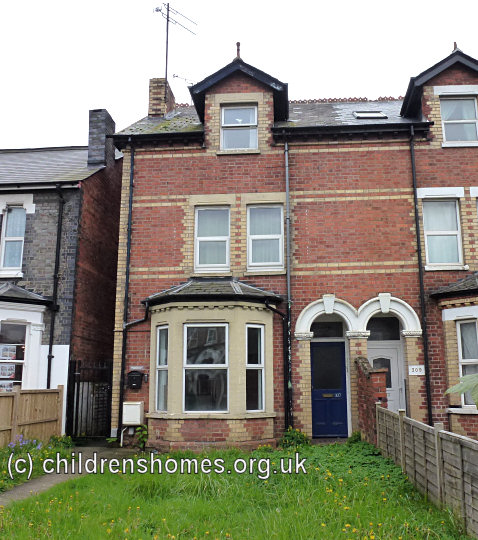
Former Prospect Lodge Home For Boys, Reading, 2014. © Peter Higginbotham
In 1896, the home was taken over by the Waifs and Strays Society, accommodating fifteen boys between the ages of 8 and 13. It was superintended by Miss Sarah Vaughan.
In 1902, the home moved to larger premises at Elm Lodge, a large house at the south side of Oxford Road. The new home, which could now accommodate 40 boys, was officially opened on 14th May, 1902, by the Lord Lieutenant of Berkshire, Mr J. Herbert Benyon, It was dedicated as St Andrew's Home by the Bishop of Oxford, Francis Paget. The proceedings took place in a large tent at the rear of the home.
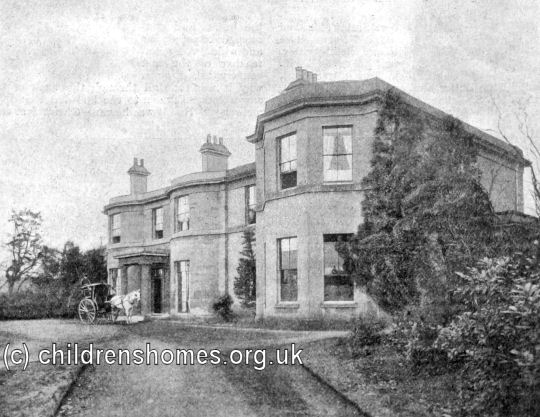
St Andrew's Home For Boys, Reading, 1902. © Peter Higginbotham
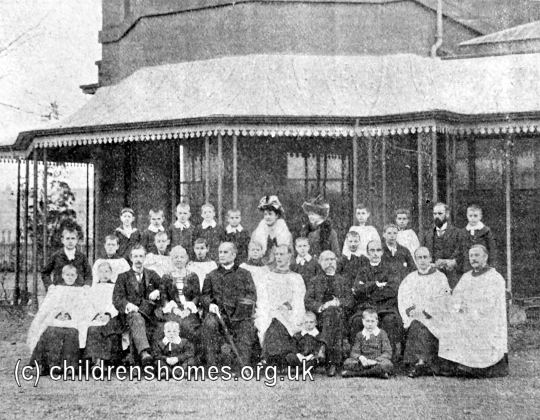
St Andrew's Home For Boys dedication, Reading, 1902. © Peter Higginbotham
The layout of the home in 1911 is shown on the map below.
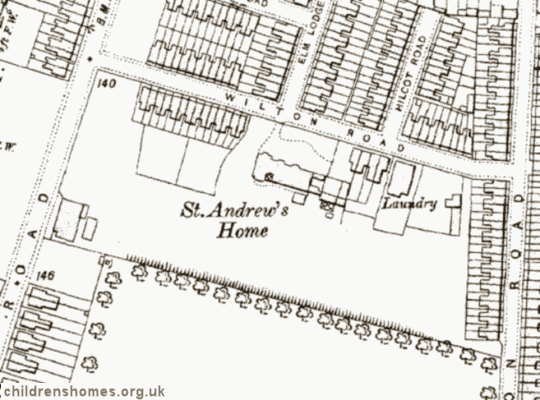
St Andrew's Home For Boys site, Reading, c.1911.
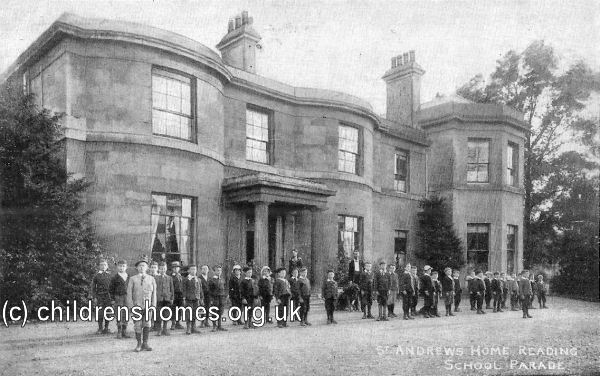
St Andrew's Home For Boys, Reading, from the north-east, early 1900s. © Peter Higginbotham
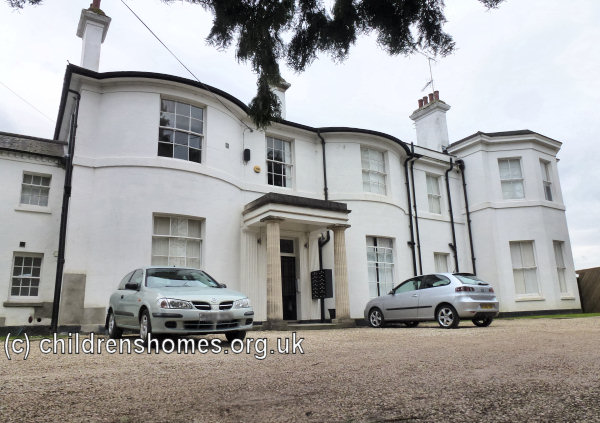
Former St Andrew's Home For Boys, Reading, from the north-east, 2014. © Peter Higginbotham
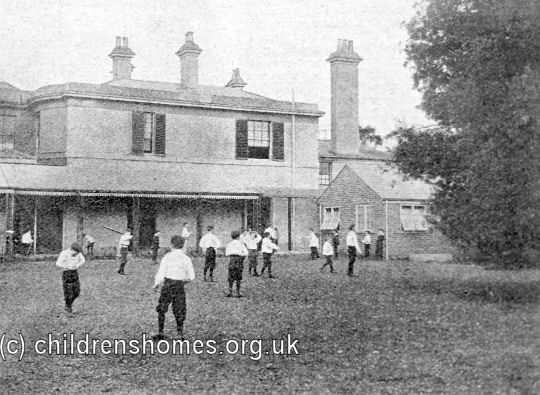
St Andrew's Home For Boys, Reading, from the south-west, 1902. © Peter Higginbotham

St Andrew's Home For Boys, Reading, from the south-west, early 1900s. © Peter Higginbotham
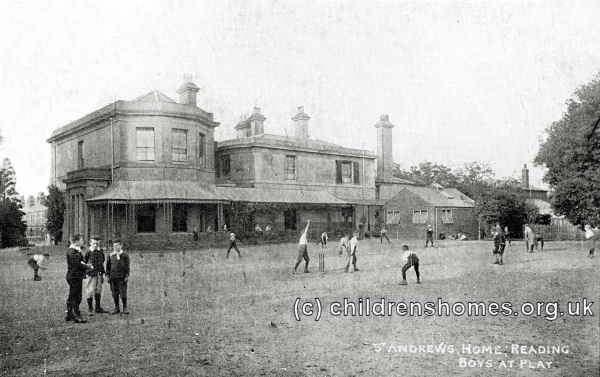
St Andrew's Home For Boys, Reading, from the south-west, early 1900s. © Peter Higginbotham
The boys' industrial training included gardening.

St Andrew's Home For Boys gardening, Reading, 1902. © Peter Higginbotham
They also helped with the household chores, including boot cleaning.
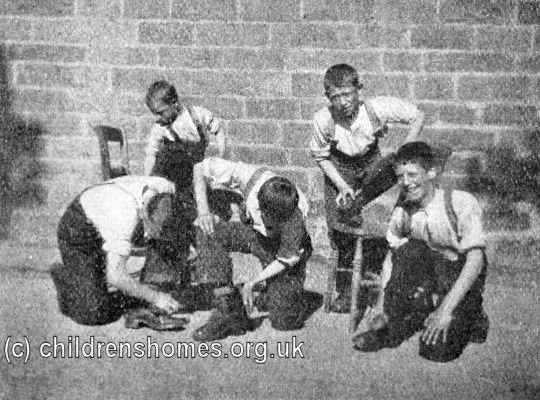
St Andrew's Home For Boys gardening, Reading, c.1903. © Peter Higginbotham
Many of the boys from the home were emigrated to Canada.
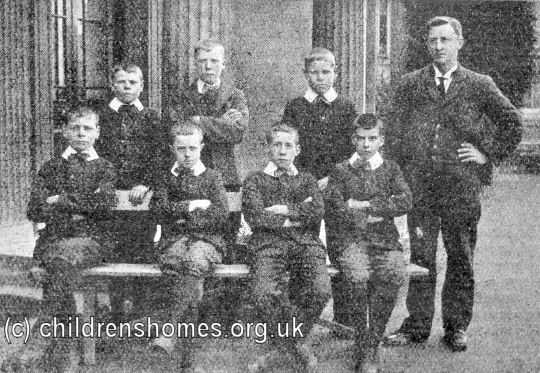
St Andrew's Home For Boys emigration party, Reading, 1910. © Peter Higginbotham
In 1903, during a severe thunderstorm, a large Wellingtonia cedar tree in the grounds of the home was struck by lightning and completely destroyed, with pieces thrown more than thirty yards. Being only sixteen yards from the front of the home, where 39 boys and the officers were sleeping, this caused terror among the inmates, but they were soon calmed by the master.
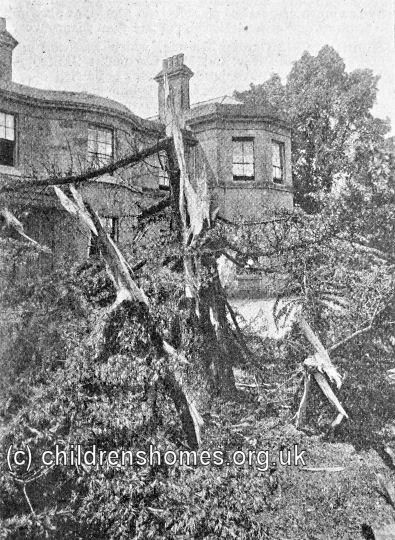
St Andrew's Home For Boys tree after lightning strike, Reading, c.1903. © Peter Higginbotham

St Andrew's Home For Boys, Reading, c.1912. © Peter Higginbotham
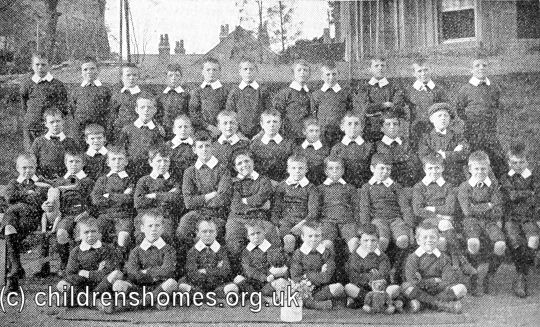
St Andrew's Home For Boys, Reading, c.1912. © Peter Higginbotham
Boys at the home participated in local organisations such as the Boy Scouts, and its bugle band also performed at community events such as fêtes. The home also had its own tug-of-war team.
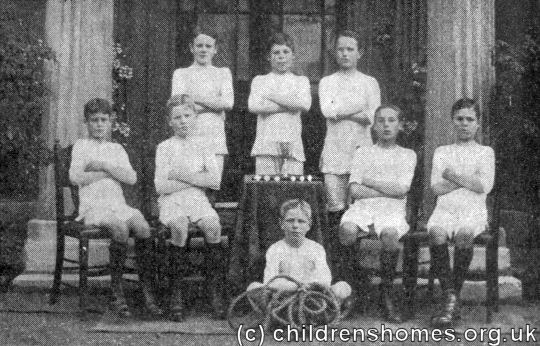
St Andrew's Home For Boys, Reading, tug-of-war team, 1921. © Peter Higginbotham

St Andrew's Home For Boys, Reading, c.1931. © Peter Higginbotham
The home became mixed in 1948. After a major refurbishment in 1971, it started to include children with diabetes amongst its residents. However, with the move away from residential child care, the home was closed in 1975.
Records
Note: many repositories impose a closure period of up to 100 years for records identifying individuals. Before travelling a long distance, always check that the records you want to consult will be available.
- Index of the Society's first 30,000 children's case files ordered by surname.
- Index of the Society's first 30,000 children's case files ordered by date of birth.
- The Children's Society Records and Archive Centre is at Unit 25, Springfield House, 5 Tyssen Street, London E8 2LZ (email: archives@childrenssociety.org.uk). Files for children admitted to its homes after September 1926 were microfilmed in the 1980s and the originals destroyed. Some post-1926 files had already been damaged or destroyed during a flood. The Society's Post-Adoption and Care Service provides access to records, information, advice, birth record counselling, tracing and intermediary service for people who were in care or adopted through the Society.
- The Society has produced detailed catalogues of its records relating to disabled children, and of records relating to the Children's Union (a fundraising body mostly supported from the contributions of children).
Bibliography
- Bowder, Bill Children First: a photo-history of England's children in need (1980, Mowbray)
- Church of England Waifs and Strays' Society [Rudolfe, Edward de Montjoie] The First Forty Years: a chronicle of the Church of England Waifs and Strays' Society 1881-1920 (1922, Church of England Waifs and Strays' Society / S.P.C.K.)
- Higginbotham, Peter Children's Homes: A History of Institutional Care for Britain's Young (2017, Pen & Sword)
- Morris, Lester The Violets Are Mine: Tales of an Unwanted Orphan (2011, Xlibris Corporation) — memoir of a boy growing up in several of the Society's homes (Princes Risborough, Ashdon, Hunstanton, Leicester) in the 1940s and 50s.
- Rudolf, Mildred de Montjoie Everybody's Children: the story of the Church of England Children's Society 1921-1948 (1950, OUP)
- Stroud, John Thirteen Penny Stamps: the story of the Church of England Children's Society (Waifs and Strays) from 1881 to the 1970s (1971, Hodder and Stoughton)
Links
- Hidden Lives Revealed — the story of the children who were in the care of The Children's Society in late Victorian and early 20th Century Britain.
- The Children's Society
Except where indicated, this page () © Peter Higginbotham. Contents may not be reproduced without permission.


